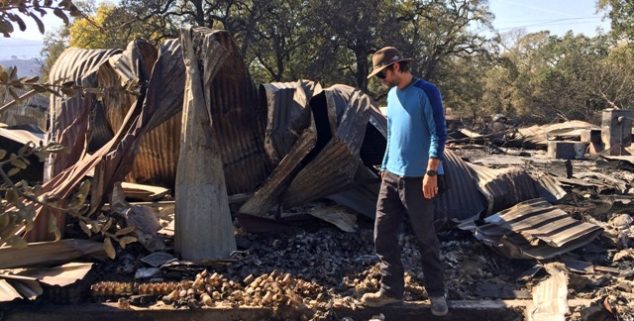News
In NorCal fires, weed goes up in smoke
 In this Oct. 17 photo, Marcos Morales, co-founder of the cannabis company Legion of Bloom, stands on the ruins of a state-of-the-art drying shed in Glen Ellen, Calif., where 1,600 pounds of ready-to-ship cannabis were destroyed in a fire. (Associated Press/Paul Elias)
In this Oct. 17 photo, Marcos Morales, co-founder of the cannabis company Legion of Bloom, stands on the ruins of a state-of-the-art drying shed in Glen Ellen, Calif., where 1,600 pounds of ready-to-ship cannabis were destroyed in a fire. (Associated Press/Paul Elias)It’s being called the Wine Country Fire, but the fatal October fires that blackened nearly 200,000 acres across Northern California might also be called the Cannabis Country Fire.
The latest estimates from the California Department of Insurance are that the fires overall resulted in damaging or destroying more than 14,700 homes, 728 businesses, and more than 3,600 private autos, commercials vehicles, agricultural equipment and watercraft.
It’s estimated that some 32 cannabis growers have reported “significant to complete” loss of their crops so far from the fires.
Total damage has hit $3.3 billion and counting. Insurance Commissioner Dave Jones says the figure is sure to grow as more insurance claims come in. Forty-two people died.
While most of the coverage has focused on damage to the losses of homes, business structures and the wine industry, marijuana growers were also hit hard.
Hezekiah Allen, executive director of the California Growers Association, has estimated that some 32 cannabis growers have reported “significant to complete” loss of their crops so far from the fires. The figure could climb as growers further survey the damage, he said.
In Sonoma County, cannabis was expected ultimately to rival the thriving beer and wine industries. Now, the future is in doubt.
“The cannabis program was finally starting to grow legs and take off. This will have a devastating impact,” Tim Ricard, Sonoma County cannabis program manager, told the Press Democrat.
Fund-raisers to help cannabis growers was scheduled tonight (Nov. 6) in Santa Rosa at the Hyatt Vineyard Creek, Dry Creek Ballroom and Knight Valley Gardens.
The ultimate impact on prices to the cannabis consumer also is unknown.
“It’s incredibly difficult to estimate the full loss at this time. Smoke and ash damage are still being assessed,” said Lindsay Robinson, executive director of the California Cannabis Industry Association.
There are bout 40,000 cannabis farms in the state, scattered from the far north to the Salinas Valley to Desert Hot Springs in the south.
With an estimated crop of 13 million pounds per year, California is America’s leading domestic producer of cannabis. Exact figures are hard to come by, but estimates are that about 80 percent of it is shipped out of state.
State Treasurer John Chiang, who chaired a banking advisory panel on cannabis, and other fiscal authorities have estimated the annual cash value of California’s cannabis industry at about $6 billion, once the industry is fully up and running.
While the Northern California fires have been devastating to many cannabis growers and the full extent of the damage will not be known for months, there are still plenty of places in California where marijuana is growing.
Allen says there are an estimated 40,000 cannabis farms in the state, scattered from the far north to the Salinas Valley to Desert Hot Springs in the south.
Nonetheless, there is speculation that damage done to marijuana crops in Sonoma, Napa and Mendocino Counties might drive up prices just as California begins to allow recreational use of marijuana on Jan. 1.
Mendocino County is part of California’s “Emerald Triangle” — Humboldt, Trinity and Mendocino counties — at the heart of the state’s marijuana cultivation.
Medical marijuana use has been legal in California for two decades. while recreational use of weed was approved by voters last year in Proposition 64.
New state rules regulating cannabis are expected to be unveiled in a matter of weeks by Lori Ajax, the state’s top cannabis regulator, although cannabis use and cultivation remains illegal under federal law.
The situation is especially difficult for cannabis growers because they are not entitled to assistance from the Federal Emergency Management Agency, or FEMA, and insurance, when available, is skimpy and expensive. On Nov. 2, Insurance Commissioner Dave Jones announced state approval of the first insurer in California to offer commercial cannabis insurance.
“This is the first of what I hope will be many commercial carriers filing insurance products to fill insurance coverage gaps for the cannabis industry,” Jones said.
“We do know that many of our industry folks have suffered tremendous loss, professionally and personally, as they’ve not only lost their livelihoods at a pivotal moment for the cannabis market but also their homes and sense of security,” Robinson told Capitol Weekly.
“Efforts to rebuild have already begun as the cannabis industry, especially the cultivators, are incredibly resilient having faced many years of uncertainty in an unregulated market. It will be a long hard road for many of the folks that lost their farms,” she added.
Want to see more stories like this? Sign up for The Roundup, the free daily newsletter about California politics from the editors of Capitol Weekly. Stay up to date on the news you need to know.
Sign up below, then look for a confirmation email in your inbox.

Are we gong to have a telethon for them? “give money for weed in need” lol